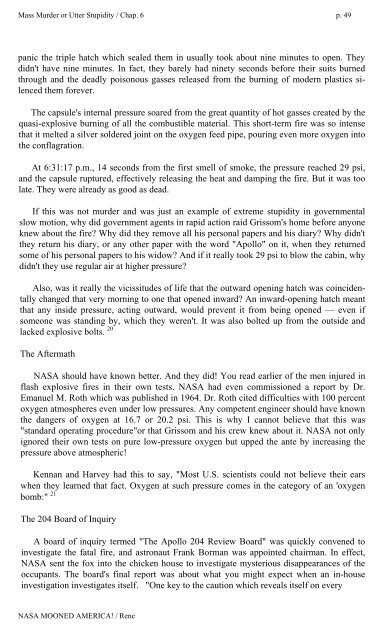Rene-NASA-Mooned-America
Rene-NASA-Mooned-America
Rene-NASA-Mooned-America
Create successful ePaper yourself
Turn your PDF publications into a flip-book with our unique Google optimized e-Paper software.
Mass Murder or Utter Stupidity / Chap. 6 p. 49<br />
panic the triple hatch which sealed them in usually took about nine minutes to open. They<br />
didn't have nine minutes. In fact, they barely had ninety seconds before their suits burned<br />
through and the deadly poisonous gasses released from the burning of modern plastics silenced<br />
them forever.<br />
The capsule's internal pressure soared from the great quantity of hot gasses created by the<br />
quasi-explosive burning of all the combustible material. This short-term fire was so intense<br />
that it melted a silver soldered joint on the oxygen feed pipe, pouring even more oxygen into<br />
the conflagration.<br />
At 6:31:17 p.m., 14 seconds from the first smell of smoke, the pressure reached 29 psi,<br />
and the capsule ruptured, effectively releasing the heat and damping the fire. But it was too<br />
late. They were already as good as dead.<br />
If this was not murder and was just an example of extreme stupidity in governmental<br />
slow motion, why did government agents in rapid action raid Grissom's home before anyone<br />
knew about the fire Why did they remove all his personal papers and his diary Why didn't<br />
they return his diary, or any other paper with the word "Apollo" on it, when they returned<br />
some of his personal papers to his widow And if it really took 29 psi to blow the cabin, why<br />
didn't they use regular air at higher pressure<br />
Also, was it really the vicissitudes of life that the outward opening hatch was coincidentally<br />
changed that very morning to one that opened inward An inward-opening hatch meant<br />
that any inside pressure, acting outward, would prevent it from being opened — even if<br />
someone was standing by, which they weren't. It was also bolted up from the outside and<br />
lacked explosive bolts. 20<br />
The Aftermath<br />
<strong>NASA</strong> should have known better. And they did! You read earlier of the men injured in<br />
flash explosive fires in their own tests. <strong>NASA</strong> had even commissioned a report by Dr.<br />
Emanuel M. Roth which was published in 1964. Dr. Roth cited difficulties with 100 percent<br />
oxygen atmospheres even under low pressures. Any competent engineer should have known<br />
the dangers of oxygen at 16.7 or 20.2 psi. This is why I cannot believe that this was<br />
"standard operating procedure"or that Grissom and his crew knew about it. <strong>NASA</strong> not only<br />
ignored their own tests on pure low-pressure oxygen but upped the ante by increasing the<br />
pressure above atmospheric!<br />
Kennan and Harvey had this to say, "Most U.S. scientists could not believe their ears<br />
when they learned that fact. Oxygen at such pressure comes in the category of an 'oxygen<br />
bomb:" 21<br />
The 204 Board of Inquiry<br />
A board of inquiry termed "The Apollo 204 Review Board" was quickly convened to<br />
investigate the fatal fire, and astronaut Frank Borman was appointed chairman. In effect,<br />
<strong>NASA</strong> sent the fox into the chicken house to investigate mysterious disappearances of the<br />
occupants. The board's final report was about what you might expect when an in-house<br />
investigation investigates itself. "One key to the caution which reveals itself on every<br />
<strong>NASA</strong> MOONED AMERICA! / <strong>Rene</strong>


